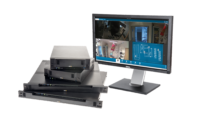If you’ve run a security business for a long time then you know operations as well as the back of your hand. You thoroughly understand the lifespan of security equipment and customers’ expectations for service when that equipment fails. But maybe you only think you know; maybe your grasp on those facts are slipping in light of today’s technology that is moving — in the words of ADT’s CEO, Tim Whall — “as fast as fast can.”
In an article published on LinkedIn January 22, 2016, titled, “Keep up! – Adapting to an ever-changing business and technology world,” author Anna Britnor Guest writes: “Whatever business you’re in, we’re all in the same boat: How do we protect our existing revenues and current customer needs AND be on the front foot (whether as disrupter or follower) for the next wave of innovation?” (http://bit.ly/2iJmFye)
I had the privilege of attending a keynote speech at last month’s Barnes Buchanan Conference, where Whall shared his insights about both the industry and ADT, having been appointed ADT’s CEO in May 2016. In the context of technology innovation, Whall compared today’s rapid pace to yesterday’s unhurried pace and longevity, where installed systems lasted 15 to 25 years. “You look at the stuff we’re putting in today — what is the chance that [it] is going to be working in five years?” he asked rhetorically.
About CES (formerly named the Consumer Electronics Show) Whall commented, “They don’t even have the stuff out and they’re telling you about the next gen. I’m thinking for service, how many of these will I have in five years — will we be on version 8? What will the service truck of the future look like? How would I ever carry all this stuff? It’s moving so fast — nobody’s worried about the widget they’re giving you today because no one’s even planning on that thing being the widget in five years,” Whall described.
I say we go the other way with it; I say learn everything about the connected devices in the home and become the expert. — Tim Whall, ADT CEO
While replacing a product’s batteries used to be the concern of security service companies, now they will have to replace whole devices. How will the industry deal with that in the future? he asked.
Another aspect of how today’s technology has changed the nature of security dealers’ service issues is the Internet. A common service call, Whall explained, is from a customer whose app isn’t showing him his security camera. Often the customer is not on-site to check the camera or to reset his router; he’s just dealing with the fact that his system isn’t working.
“I’m supposed to be the security guy. I’m supposed to be 24/7. I’m supposed to be the one protecting what’s out there,” Whall described of the industry. “And we’re kind of caught in a technology gap right now. Whose job is that? We’re doing a little bit of pointing. We’re saying, ‘Hey we actually use the Internet to transmit — I’m not sure your Internet connection is good.’”
With the Internet as the “third party” inside of the home over which the dealer historically hasn’t had control, “we don’t know how many things you have on the router; we don’t know what type of router you have; how many networks you are running. Do you even have a design that could possibly work? Have you loaded a new app that’s caused everything else to have to get reset?”
According to the 2015 Edelman Trust Barometer 51 percent of people think the pace of business innovation is too fast — and that affects their trust in new innovations (http://bit.ly/180nRrH). But in the case of security, considered to be the gateway to the home for connected devices and services, it’s documented that customers already trust security companies to be in their homes.
Therein lies the opportunity, Whall believes. “What are the customers asking for? They would love it if they had one number to call to solve their technology issues in the house. As an industry, I see everybody wanting to get close to us from the manufacturers’ side. I see them trying to sell what we sell.
“I say we go the other way with it; I say learn everything about the connected devices in the home and become the expert. And if you can deliver an app that’s easy to use, that’s reliable, that has speed to it, that’s intuitive for the customer, why wouldn’t they come to you for everything inside the home that’s connected? I see it as a possibility.”
It’s great food for thought as we embark upon the 2017 ISC West.




